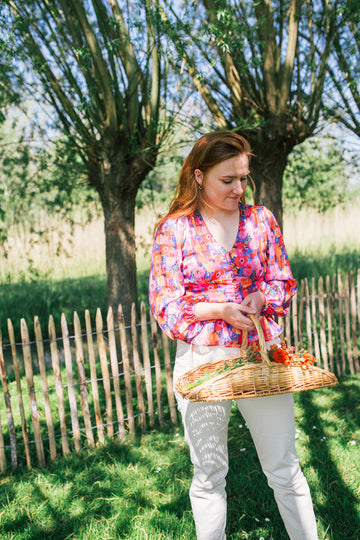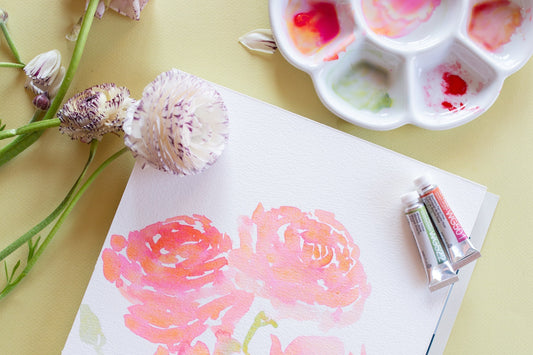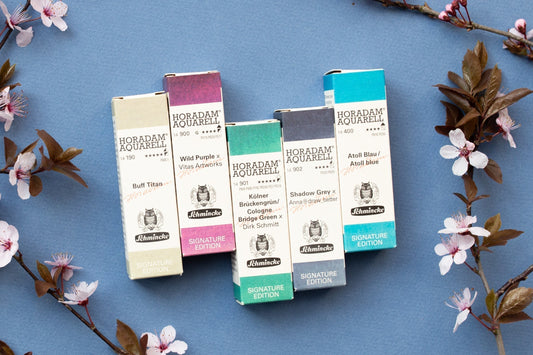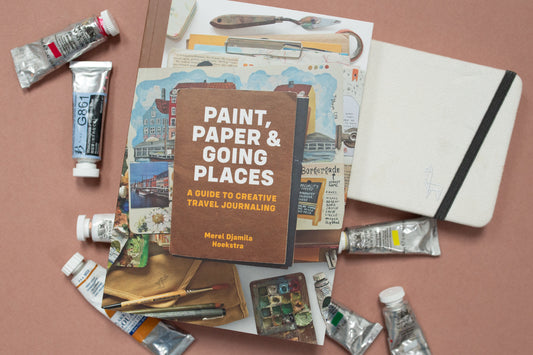Hi all!
Finally: the long-promised review of calligraphy nibs that you can find in my webshop! The range of nibs is now so large that it can be very confusing for you... I mean: WHICH ONE works best?! Unfortunately you can't judge them by their appearance, but where do you start! In this blog I try to explain it to you :). At the end of the blog I introduce two NEW items!
This blog is no guarantee that you will immediately know what the best nib is for you. Everyone has different handwriting and applies different pressure to a pen. It is super personal whether a calligraphy nib becomes your favorite or whether it ends up in your trash bin out of frustration. And YES! During this test, I demonstratively and dramatically threw a pen into the trash can out of frustration, haha!
A few years ago I spent a long time looking for which calligraphy pens/nibs I should order. I ended up ordering a whole bunch and after trying them out they turned out to be much more for advanced calligraphers. I also did not have a suitable pen holder for some nibs. So looking for materials alone was quite a challenge. I wrote this blog for you, to save you the whole search. I mean: the calligraphy itself is much more fun, isn't it?! Hopefully you understand this blog, whether you're just starting out or you're already a pro.
Oh, and as you can tell from my handwriting, I'm not a pro. I especially enjoy inspiring you to get started. And for now I have to let go of the fact that I am not completely satisfied with these manuscripts. Most importantly, in this blog you can see what different effects different calligraphy pens/nibs can have. By the way, I press quite hard on my pen, so keep that in mind when reading :).
The 'mount size' is different for many pens. This means that not all pens fit in every pen holder . To avoid making the blog even longer, you will find the information for the pen holder in the product text itself.
Let's get started! Check the end of the blog for a NEW item!

Japanese G nibs:
The G nibs have many similarities, they are all semi-flexible. Everyone has their personal preference, here are my experiences:
Nikko G
The Nikko G nib is the most ideal pen for learning calligraphy. The ink flows easily from the nib for beautiful flowing letters. The sharp point allows you to make thin upstrokes. Great for Copperplate and Modern Calligraphy.
Tachikawa G
The Tachikawa G Nib has similar properties to the Nikko G and the Zebra G. With these nibs you can make both thin upstrokes and thicker downstrokes. Opinions are divided as to whether this nib is the most or least flexible of the three G nibs. Try them all out!
Zebra G
The Zebra G has a slightly less sharp point than the other two, but you can make the thinnest upstrokes with the Zebra G. This nib is my favorite of the three!
Zebra G Titanium
This calligraphy nib is an upgrade of the Zebra G nib. The titanium version lasts about 4x as long compared to the regular Zebra G.

Brause Calligraphy pens:
Brause Index
I especially like the Brause Index nib because of its shape. You may already be able to tell from the writing that the nib is not flexible at all. So you're just walking a fine line.
Brause Steno
Must have! A nice sturdy semi-flex calligraphy nib. Also very nice to use as a beginner. The nib is also well suited for writing on textured paper.
Brause 66EF
Must Have! The Brause 66EF is my absolute favorite! Flexible for nice thick downstrokes and comfortable to write with. Nice thin upstrokes, while the nib is not very sharp.
Brause Rose
Must Have! It is not only a very beautiful pen, but also provides beautiful results! Nice thick upstrokes but also thick downstrokes. You need some practice with this pen before you can write well with it. In the beginning you will sometimes suffer from ink blobs.

Hunt calligraphy nibs:
Hunt 22
Must try! A fine calligraphy pen for finer work, easy to use. Slightly more flexible than the Hunt 56. Comparable to the Gillott 404. With this nib you can create both thin hairlines and beautiful letter curls. This nib is also great to use on paper with a light structure.
Hunt 56
Must try! A sturdy nib, with a sharp point. Ideal for fine hairlines. Requires a little more force for a thicker line.
Hunt 99
Must try! A mega flexible pen, and also very delicate. Provides beautiful results. Do you plan to write a lot with this pen? Then order 2, because the pen is damaged quite quickly, especially because it is so flexible. Can lose ink quickly.
Hunt 100
This nib is used to draw extremely thin lines. The pen is not suitable for calligraphy because it is too delicate for that. That is why I cannot share those results in the blog. This pen is suitable for very fine pen drawings!
Hunt 101
Must have! I think the Hunt 101 has a nice sharpness and is nice and flexible.
The Hunt 101 and EF Principal come close together. Opinions differ about the sharpness of the point. I find this more comfortable to write on, but I also read other opinions that the Hunt 101 scratches a bit more.
Hunt 107
The Hunt 107 is a completely inflexible mapping nib.
Hunt 108
In contrast to the Hunt 107, the Hunt 108 is a bizarrely flexible mapping nib, on the flexible side for a beginner.
Hunt 512
A non-flexible calligraphy pen.
Hunt 513
A very large calligraphy pen, and not flexible at all


Leonardt Calligraphy nibs:
Leonardt EF Principal
Must try! A flexible nib and very popular among calligraphers. A sharp point for very fine lines and a nice contrast with the thick lines.
Leonardt Hiro 41
Must have! Oh no, I wrote this wrong on the card! Hiro 41 is the traditional dip pen, nice to write with. Holds quite a bit of ink and has nice flexibility. Can lose ink quickly.
Leonardt 30
Must try! Nice sturdy nib, but flexible. Nice nib to write with, even as a beginner.
Leonardt IIIEF
Must try! Not a flexible pen, but nice to write with, for example, minimalist handwriting.
Leonardt 300
This is actually a ballpoint pen nib, which you can tell by the point that bends slightly at the end. Not really a big difference between up and down strokes.
Leonardt General
Must try! When I tried this pen on smooth paper, I thought: what should I do with this!? No ink came off the nib at all. I almost gave up hope until I tried different paper. On structured paper, the Leonardt General wrote fantastically. It is semi-flexible and especially nice for larger handwriting.


Gillott calligraphy nibs:
Gillott 170
Must try! Fairly sturdy nib, nice for writing on structured paper such as watercolor paper.
Gillott 290
Very difficult pen to write with!
Gillott 291
With a lot of pain and effort I managed to write with this pen. I don't recommend this one for beginners, actually to anyone. Hmm, can anyone tell me what I did wrong with this? So this one ended up in the trash...haha!
Gillott 303
Must try! A popular nib, especially for copperplate. The 303 is slightly stiffer than the Gillott 404 and has a fairly sharp point. The Gillott 303 is a favorite for many professional calligraphers. Works best on smooth paper, but also works on slightly structured paper.
Gillott 404
Must have! Also a nice nib to use as a beginner. Works well on multiple surfaces, including textured paper. Eleonor Winters recommends this pen in herbook as a pen for thin lines, without being too fragile. The firmness is comparable to the Nikko G
Gillott 659
Not recommended for beginners. Maybe fun to try out if you are an advanced calligrapher.
Gillot 850
Not recommended for beginners. Maybe fun to try out if you are an advanced calligrapher.
Gillott 1068
Must try! A fairly sturdy nib, also nice to use as an advanced beginner. Not much difference between the thick and thin lines.
Gillott 1950
Not recommended for beginners. Maybe fun to try out if you are an advanced calligrapher.
Sets with calligraphy nibs!
If you want to start: start with a Nikko G, Zebra G or Brause Steno. Are you looking for a supplement for beginners' nibs? To make it even easier for you, there are now two sets of calligraphy nibs online! You can shop them here!
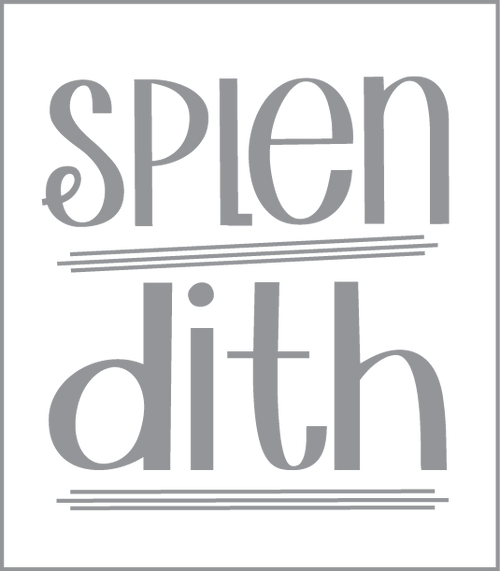
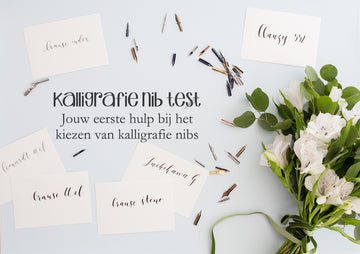
 Love,
Love,